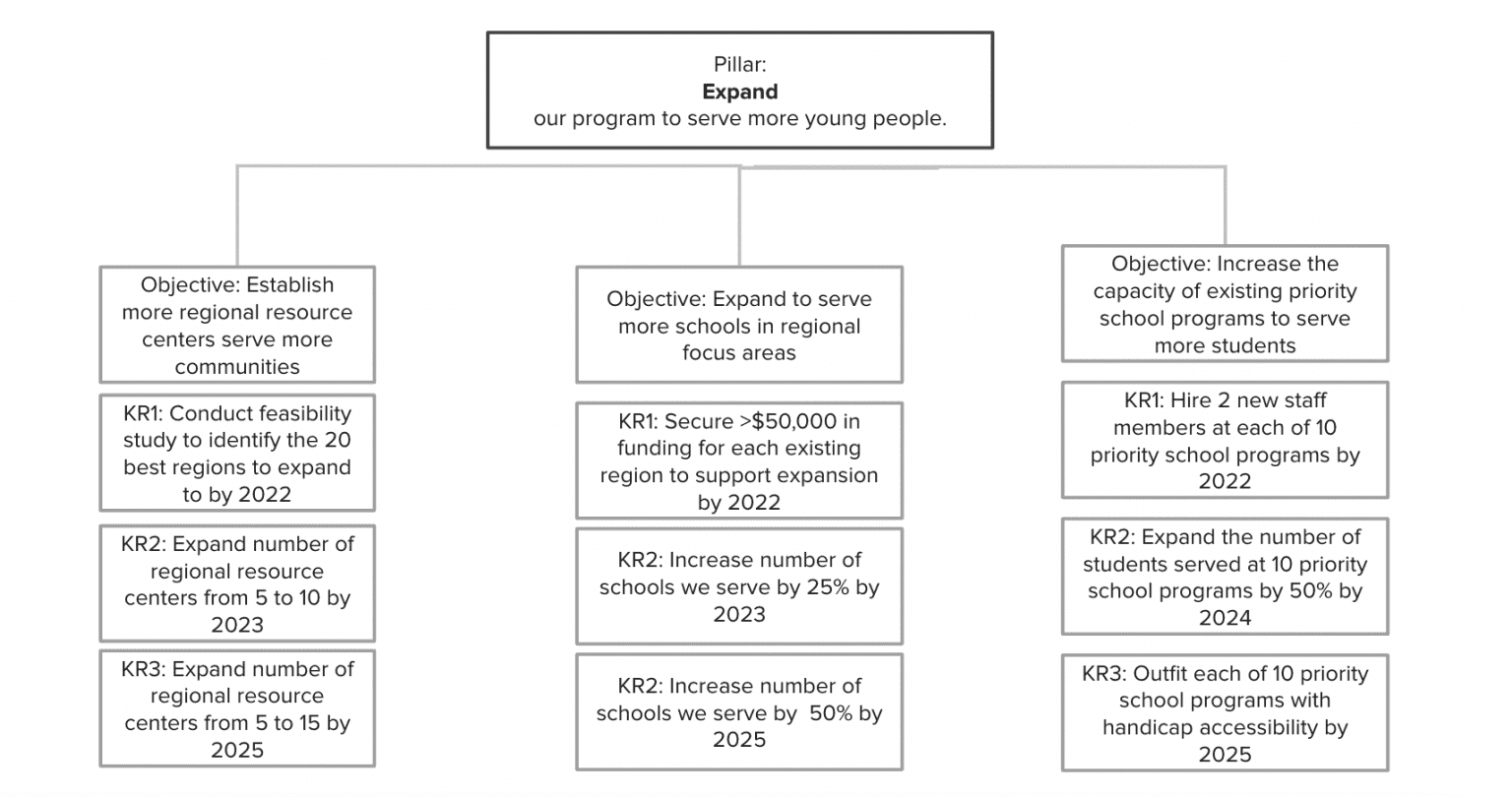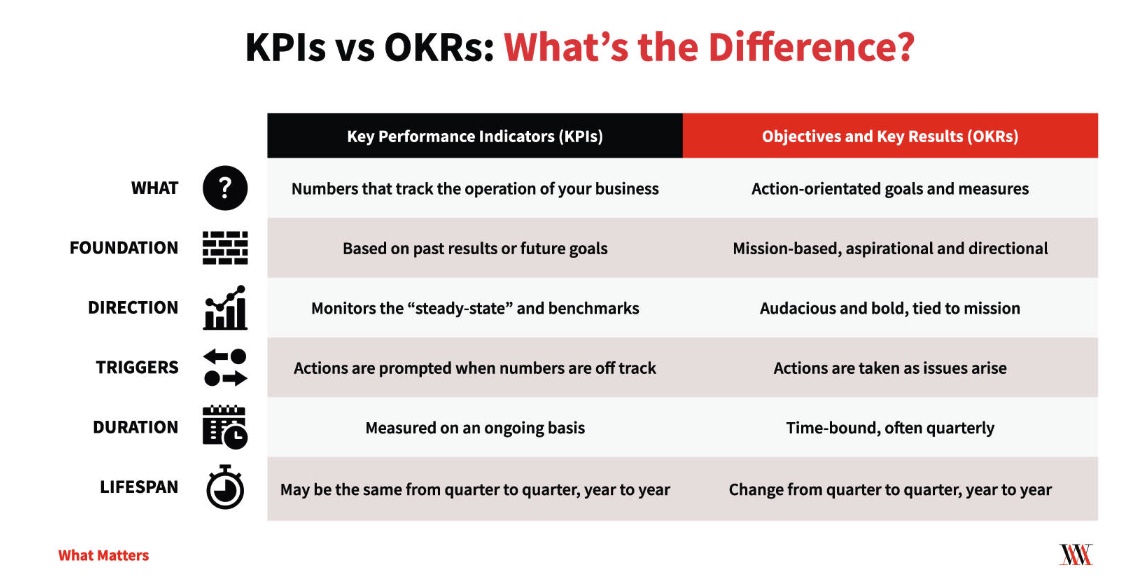When we kick off an Objectives and Key Results (OKRs) workshop with one of our nonprofit clients, you can almost feel the room tightening and blood pressures going up. This is usually on the heels of visionary thinking and the development of big new strategies, where the room is quite literally buzzing, making the stark change in atmosphere all the more obvious.
Why doesn’t the nonprofit sector always love metrics? I think a lot of it has to do with the fact that most metrics systems were designed for for-profit businesses that don’t consider the double (or triple) bottom lines of nonprofits. They’re too quantitatively driven and don’t consider why most people get into the nonprofit sector, which is for the mission. However, metrics are extremely important for understanding progress, or lack thereof, toward your goals and providing transparency to your organization’s stakeholders.
Because of the unique nature of nonprofits and the metrics that are necessary to track, we base the Progress element of the Nonprofit Impact SystemTM in OKRs. We like the flexibility of the system and the regular cadence of check-ins it requires. We couple OKRs with strategic goal setting (which we refer to as pillars) and the regular tracking of nonprofit key performance indicators (nonprofit KPIs). We believe it’s the combination of these three systems that help nonprofits achieve results and advance their mission.
So what are pillars, OKRs and nonprofit KPIs? When do you need them and how do you use them?
- Pillars provide overall strategic direction to define how you’re working together to advance your nonprofit’s mission
- OKRs provide a roadmap for how you will reach your pillars
- Key performance indicators give a snapshot into your organization’s top line metrics
When combined, these three systems will provide your nonprofit with what you need to measure overall organizational health, your progress toward change, and the advancement toward achieving your mission.
Goals (also known as pillars)
Pillars are the big priorities your organization must focus on in order to advance its mission and drive toward its vision, no matter what, over the next 3 years. We use pillars in addition to OKRs, because pillars connect the work outlined in OKRs to your mission.
Nonprofits typically create pillars during a strategy development process and they become the themes around which OKRs are organized. For example, if your mission is to end veteran homelessness by connecting veterans with housing and supportive services, your pillars may be about expanding mental health care services, creating partnerships with local employers and working with local developers to identify more housing options.
Pillars are inspiring. They help people understand the ambitious work your nonprofit is doing every day to advance its mission.
Just as Prosper has added pillars to the OKRs system, The YMCA of the North, which serves the Greater Twin Cities region sets MOKRs, or Mission, Objectives and Key Results.
“Adding the mission component assuaged concerns that OKRs might be ‘a little too businessy, a little too for-profit driven versus community driven,'” said Glen Gunderson, President of The YMCA of the North in an article on WhatMatters.com.
The article goes on to note, “In a non-profit setting, that balance is often a delicate dance. Without any metrics, it can be difficult to track whether actions are leading to significant change. But focusing too narrowly on metrics can make employees feel disconnected from mission, raising the risk of burnout.”
Objectives and Key Results (OKRs)
While pillars are bold and inspiring, objectives are specific descriptions of the most important things you need to accomplish under each pillar, over the next 3 years. You typically set three to four objectives per pillar. Objectives are:
- Ambitious: objectives should represent a significant change or leap forward, not something that would be likely to happen through continuing “business as usual.”
- Memorable: objectives should be concise and easy to remember, recite and reflect on while you’re going about your day-to-day work.
- Mission-aligned: objectives should play a clear role in advancing your organization’s mission.
So taking the example from above of the organization focused on veteran homelessness, if your pillars are about expanding mental health care services, creating partnerships with local employers and working with local developers to identify more housing options, some of your objectives might be along the lines of:
- Open more counseling centers
- Build a pipeline of local businesses
- Create a strategy for acquisition of new housing
Then, once you’ve set your objectives, you set your key results. These are the benchmarks you can measure and track to determine whether your objectives are being achieved. You typically set two to five key results per objective.
Key results are quantitative and time bound. The best key results are a healthy mix between output and outcome-oriented key results:
Output-oriented key results describe the key milestones that need to be hit in the process of accomplishing the objective. For example:
- Open 2 new counseling centers by the end of 2024
- Develop partnerships with 10 of the top 100 local businesses by the end of 2023
Outcome-oriented key results describe the measurable change that occurs in the process of working toward the objective. They describe growth, optimization or improvement. For example:
- Increase housing options by 50% by the end of 2025
- Decrease veteran homelessness by 10% by the end of 2030
Key results are typically graded quarterly on a scale of 0-100% and then averaged to produce an overall objective score. The OKR model maintains that a score of 70% or higher is considered passable or good.

The combination of pillars, objectives and key results ensures your plans are inspiring, while also measurable and achievable.

OKRs are all about change-oriented metrics, but what about day-to-day performance metics? Don’t those still need to be monitored and tracked? This is where nonprofit KPIs come in.
Nonprofit Key Performance Indicators
According to KPI.org: Key Performance Indicators (KPIs) are the critical (key) quantifiable indicators of progress toward an intended result. KPIs provide a focus for strategic and operational improvement, create an analytical basis for decision making and help focus attention on what matters most.
So key performance indicators are tracked on a monthly, weekly and sometimes daily basis, allowing your nonprofit to track the health of your organization and its activities. Example nonprofit KPIs include tracking things like:
- Number of people served
- Web traffic
- New donors
- Lapsed donors
- Grant conversation rates
WhatMatters.com writes:
Most organizations are familiar with KPIs, or Key Performance Indicators. Nonprofit KPIs can be great for measurement, but they’re standalone metrics — they may tell you when a measure is good or bad, but they don’t necessarily communicate context or what direction your team needs to go in.

Do you really need all four: pillars, objectives, key results AND nonprofit KPIs?
The answer is yes.
Pillars provide your nonprofit with overall strategic direction and inspire people to join in your mission.
Objectives and key results are change-oriented and measurable. They provide the roadmap for how you’ll achieve your pillars.
Key performance indicators are standalone numbers that provide important information about the overall performance of your organization. However, without OKRs, they don’t convey “purpose, path or progress.”
Additional Resources
OnStrategy: Your Ultimate Guide to OKRs
101 Guide: Pillars, Objectives and Key Results for Nonprofits